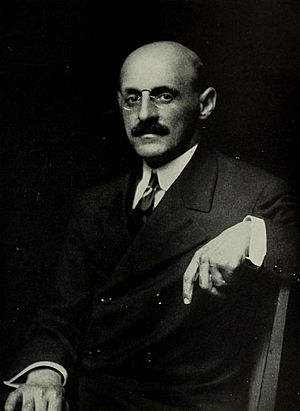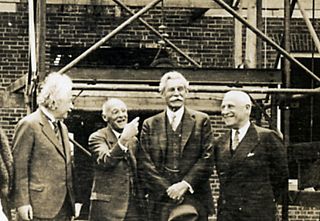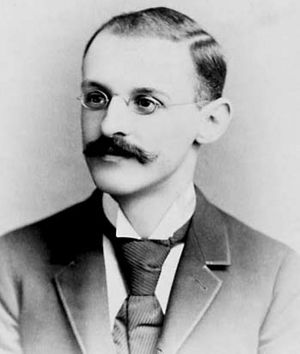Abraham Flexner facts for kids
Quick facts for kids
Abraham Flexner
|
|
|---|---|

Flexner circa 1910
|
|
| Born | November 13, 1866 Louisville, Kentucky, U.S.
|
| Died | September 21, 1959 (aged 92) Falls Church, Virginia, U.S.
|
| Resting place | Cave Hill Cemetery Louisville, Kentucky, U.S. |
| Alma mater | Johns Hopkins University (BA) Harvard University University of Berlin |
| Known for | Flexner Report |
| Spouse(s) |
Anne Laziere Crawford
(m. 1896) |
| Relatives | Louis B. Flexner (nephew) |
| Scientific career | |
| Fields | Higher education Medical education |
| Institutions | Johns Hopkins University Rockefeller Institute University of Berlin Harvard University Institute for Advanced Study |
Abraham Flexner (born November 13, 1866 – died September 21, 1959) was an American educator. He is famous for helping to improve medical and higher education in the United States and Canada during the 20th century.
Flexner started his own school in his hometown of Louisville, Kentucky. Later, he wrote a book in 1908 called The American College: A Criticism. This book looked closely at the American education system. His work caught the attention of the Carnegie Foundation. They asked him to study 155 medical schools in the US and Canada.
His report, called the Flexner Report, came out in 1910. It led to big changes in how doctors were trained. Flexner also helped create the Institute for Advanced Study in Princeton. This place brought together smart people to work on new ideas and research.
Biography
Early Life and Education
Abraham Flexner was born in Louisville, Kentucky, on November 13, 1866. He was the sixth of nine children. His parents, Ester and Moritz Flexner, were immigrants from Germany. Abraham was the first in his family to finish high school and go to college.
In 1886, at age 19, Flexner earned a bachelor's degree in classics from Johns Hopkins University. He studied there for only two years. Later, in 1905, he studied psychology at Harvard University and the University of Berlin. However, he did not finish a higher degree at either school.
Family Life
Abraham Flexner had three brothers: Jacob, Bernard, and Simon Flexner. He also had a sister named Rachel Flexner. Abraham helped pay for his brother Simon Flexner's medical education. Simon later became a well-known medical researcher.
Flexner also helped his sister Rachel pay for her college studies. His brother Jacob became a doctor, and Bernard became a lawyer.
In 1896, Flexner married Anne Laziere Crawford. She was a former student of his school. Anne became a successful writer of plays and children's books. Her popular play, Mrs. Wiggs of the Cabbage Patch, helped pay for Flexner's studies at Harvard. It also funded his year studying in Europe.
Abraham and Anne supported women's right to vote. They had two daughters, Jean and Eleanor. Jean worked for the United States Division of Labor Standards. Eleanor Flexner became a scholar who studied women's history.
Flexner grew up in a Jewish family. But as he got older, he chose not to follow a specific religion. His nephew, Louis B. Flexner, also became a famous scientist.
Later Years and Death
Abraham Flexner passed away in Falls Church, Virginia, in 1959. He was 92 years old. He was buried in Cave Hill Cemetery in Louisville, Kentucky.
Career
Starting an Experimental School
After college, Flexner taught at Louisville Male High School. Four years later, he opened his own private school. He wanted to try out new ideas about teaching. Flexner did not like the usual way of teaching. This old way focused on strict rules and memorizing facts.
"Mr. Flexner's School" was different. It did not give grades or exams. It also did not have a set curriculum. Instead, it focused on small groups and helping each student grow. It used a more hands-on way of learning. Students from his school were accepted into top colleges. His teaching style became very popular.
Writing The American College
In 1908, Flexner published his first book, The American College. In this book, he criticized many parts of American higher education. He especially disliked university lectures. He felt lectures allowed colleges to teach many students cheaply. He also worried that research was taking over the main goal of teaching students.
His book got the attention of Henry Pritchett, who led the Carnegie Foundation. Pritchett was looking for someone to study professional education. Flexner joined the Carnegie Foundation in 1908. Even though he was not a doctor, he was chosen for his writing skills and his new ideas about education.
The Flexner Report
In 1910, Flexner released the Flexner Report. This report looked at medical education in America. It led to huge changes in how doctors were trained. The report suggested that many medical schools should close or change a lot. This included some schools that served African-American students.
One of the schools affected was in Flexner's hometown. After the report, some schools even fired older teachers to make reforms.
Impact on European Education
Flexner later studied medical education in Europe. His work became well-known there too. With money from the Rockefeller Foundation, Flexner greatly influenced medical training in Europe. He helped shape some of the most famous medical schools. Some people called Flexner "the best friend American medicine ever had."
Founding the Lincoln School
From 1912 to 1925, Flexner worked for the Rockefeller Foundation's General Education Board. In 1917, he helped start another experimental school called the Lincoln School. He worked with Teachers College at Columbia University on this project.
Creating the Institute for Advanced Study

The Bamberger family, who owned a department store, wanted to create a medical school. Flexner convinced them to fund a new place for advanced learning instead. This place would be called the Institute for Advanced Study.
Flexner led the institute from 1930 to 1939. It had many famous thinkers, like Kurt Gödel and John von Neumann. During his time there, Flexner helped many European scientists come to America. They were facing danger from the rising Nazi government. This included Albert Einstein, who joined the Institute in 1933.
Writing Universities: American, English, German
In 1930, Flexner wrote another book, Universities: American, English, German. In this book, he again looked at the purpose of American universities. He criticized things that he felt distracted from serious learning. These included college sports and student activities.
Legacy
Lasting Impact on Education
The Flexner Report and Flexner's other work changed medical and higher education forever. Here are some of the main impacts:
- The quality of doctors greatly improved.
- Becoming a doctor became a respected and well-paying job.
- Doctors now need at least six, and usually eight, years of college education.
- Medical training is now based on scientific research. This includes studying human physiology (how the body works) and biochemistry (the chemistry of living things).
- Medical research follows the same rules as other scientific research.
- State governments must approve new medical schools. They also regulate existing ones.
- The state groups of the American Medical Association oversee medical schools.
The Institute for Advanced Study
The Institute for Advanced Study, which Flexner helped create, has been doing important research for over 80 years. It helps us understand the world and humanity better.
Honors
- The Association of American Medical Colleges used to give an award named after Abraham Flexner. This award honored people who made great contributions to medical education. In 2020, the award's name was changed.
- The University of Kentucky College of Medicine has an award for excellence in medical education. It was once called the Abraham Flexner Master Educator Award.
- A street in downtown Louisville's hospital area is named Abraham Flexner Way. It was named in his honor in 1978.
Images for kids
-
Albert Einstein and Abraham Flexner at the Institute for Advanced Study in 1939
See also
 In Spanish: Abraham Flexner para niños
In Spanish: Abraham Flexner para niños
- Charles Flexner (born 1956), American physician and researcher
- James Thomas Flexner (1908–2003), American historian and writer
- Simon Flexner (1863–1946), physician, scientist, and professor





